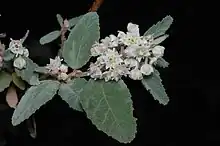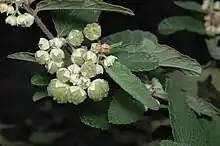| Trigwell's rulingia | |
|---|---|
 | |
| Commersonia erythrogyna in the Australian National Botanic Gardens | |
| Scientific classification | |
| Kingdom: | Plantae |
| Clade: | Tracheophytes |
| Clade: | Angiosperms |
| Clade: | Eudicots |
| Clade: | Rosids |
| Order: | Malvales |
| Family: | Malvaceae |
| Genus: | Commersonia |
| Species: | C. erythrogyna |
| Binomial name | |
| Commersonia erythrogyna | |

Commersonia erythrogyna, commonly known as Trigwell's rulingia,[2] is a species of flowering plant in the family Malvaceae and is endemic to a restricted part of the south-west of Western Australia. It is an open, straggly shrub with oblong to egg-shaped leaves and creamy-white flowers.
Description
Commersonia erythrogyna is an erect, straggly shrub that typically grows to 1–2 m (3 ft 3 in – 6 ft 7 in) high and 1.5–2.0 m (4 ft 11 in – 6 ft 7 in) wide, its new growth covered with white, star-shaped hairs. The leaves are oblong to egg-shaped, 4–19 mm (0.16–0.75 in) long and 3–12 mm (0.12–0.47 in) wide on a petiole 1–4 mm (0.039–0.157 in) long with stipules 1–4 mm (0.039–0.157 in) long at the base. The edges of the leaves sometimes have irregular teeth, and both surfaces are covered with fine, white, star-shaped hairs. The flowers are arranged in clusters of 3 to 7 on the ends of branches or opposite leaves on a peduncle 2–6 mm (0.079–0.236 in) long, each flower on a pedicel 5–20 mm (0.20–0.79 in) long with a bract 1–3 mm (0.039–0.118 in) long at the base. The flowers are 7–9 mm (0.28–0.35 in) wide with five creamy-white, petal-like sepals, five white petals with a narrow ligule, and a single, sparsely hairy white staminode between each pair of stamens. Flowering occurs from August to October and the fruit is a hairy, bristly capsule 8–10 mm (0.31–0.39 in) in diameter.[2][3]
Taxonomy and naming
Commersonia erythrogyna was first formally described in 2011 by Carolyn F. Wilkins and the description was published in Australian Systematic Botany from specimens collected near Boyup Brook in 2003.[4] The specific epithet (erythrogyna) means "red female organs", referring to the reddish hairs on the ovary.[3][5]
Distribution and habitat
Trigwell's rulingia grows in low, open jarrah and marri woodland in a single wild population of 2 mature plants on private farmland, but in 2003, five translocation sites, also on private property, have been established.[2]
Conservation status
Commersonia erythrogyna is listed as "endangered' under the Australian Government Environment Protection and Biodiversity Conservation Act 1999[2] and as "threatened" by the Western Australian Government Department of Biodiversity, Conservation and Attractions,[6] meaning that it is in danger of extinction.[7]
References
- ↑ "Commersonia erythrogyna". Australian Plant Census. Retrieved 28 March 2023.
- 1 2 3 4 "Commersonia erythrogyna". Species Profile and Threats Database. Australian Government-Department of Climate Change, Energy, the Environment and Water. Retrieved 28 March 2023.
- 1 2 Blake, Trevor L. (2021). Lantern bushes of Australia ; Thomasias & allied genera : a field and horticultural guide. Victoria: Australian Plants Society, Keilor Plains Group. pp. 182–183. ISBN 9780646839301.
- ↑ "Commersonia erythrogyna". Australian Plant Name Index. Retrieved 28 March 2023.
- ↑ Sharr, Francis Aubi; George, Alex (2019). Western Australian Plant Names and Their Meanings (3rd ed.). Kardinya, WA: Four Gables Press. p. 193. ISBN 9780958034180.
- ↑ "Commersonia erythrogyna". FloraBase. Western Australian Government Department of Biodiversity, Conservation and Attractions.
- ↑ "Conservation codes for Western Australian Flora and Fauna" (PDF). Government of Western Australia Department of Parks and Wildlife. Retrieved 28 March 2023.
